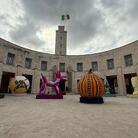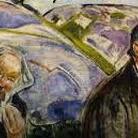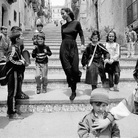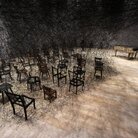Farnaz Damnabi. Unveiled

© Farnaz Damnabi | Farnaz Damnabi, Saffron worker, 2022. Courtesy of 29 ARTS IN PROGRESS gallery
Dal 22 May 2023 al 28 July 2023
Milano
Luogo: 29 ARTS IN PROGRESS gallery
Indirizzo: Via San Vittore 13
Orari: Martedì – Venerdì, 11.00 – 19.00 (ingresso libero) | Aperti sabato 27 maggio Chiusi al sabato di giugno e luglio 2023
Telefono per informazioni: +39 02 94387188
E-Mail info: staff@29artsinprogress.com
Sito ufficiale: http://29artsinprogress.com
29 ARTS IN PROGRESS gallery è lieta di presentare, dal 23 maggio al 28 luglio 2023, la prima mostra personale della giovane artista iraniana Farnaz Damnabi.
La mostra, intitolata ‘UNVEILED’, riunisce una selezione di opere che offrono al pubblico il racconto – tanto raffinato quanto potente – di una giovane donna fotografa dell’Iran contemporaneo, sospeso tra passato e futuro. Tra le protagoniste assolute dei suoi scatti, le donne: Damnabi racconta e insieme omaggia l’identità femminile iraniana, qui mostrata nella routine di donne, madri e lavoratrici ignorate da una società prettamente patriarcale, che tarda a riconoscerne l’uguaglianza, il valore, la libertà. Gli scatti in mostra evidenziano temi come la discriminazione delle donne nel mercato del lavoro, il gap di genere nei salari e il mancato riconoscimento del loro silenzioso contributo in settori portanti dell’economia e dell’artigianato iraniano (come la raccolta dello zafferano nei campi di Torbat Heydarieh o la produzione dei tappeti).
Nella serie Lost Paradise le figure femminili, ritratte di spalle di fronte ad un tradizionale tappeto persiano, sembrano mimetizzarsi – e quasi fondersi – con lo sfondo, metafora di una invisibilità tanto ottica quanto sociale.
Tra i suoi reportage più celebri, poetici nella loro drammaticità, ci sono quelli dedicati ai bambini
il cui duplice fine è non solo quello di mostrare le difficoltà di un’infanzia trascorsa in questo
paese, quanto la capacità – tipica della giovinezza – di trovare la magia anche nei contesti più avversi perché, come ci ricorda l’emblematico titolo di uno dei suoi progetti, Playing is my right (Giocare è un mio diritto).
Donne, bambini e giovani adolescenti affollano anche gli scatti della serie Metamorphosis, vera e propria raccolta di momenti sospesi, di scene di vita quotidiana, di rituali, abiti e tradizioni emblematiche dell’Iran mentre con il recente progetto Be like a Butterfly, l’Artista documenta il tentativo delle nuove generazioni di donne di migliorare la propria condizione, registrandone cambiamenti tanto lenti e tardivi da sembrare impercettibili, ricollegandosi a quella stessa metamorfosi che compiono le crisalidi diventando farfalle.
Nel personale e toccante racconto che fa della sua terra, Damnabi documenta anche l’esperimento
della nuova città sorta a pochi chilometri da Teheran.
Denominata, con triste ironia, Pardis (Paradiso), era stata pensata con l’intenzione di invertire la migrazione delle città più densamente popolate; la costruzione massiva di nuove palazzine ha portato tuttavia alla devastazione dell’ecosistema montano e alla distruzione del suo habitat naturale, accrescendo ulteriormente le difficoltà dei collegamenti con la capitale. Le immagini esposte, parte dell’omonima serie Pardis, sembrano sospese tra realtà e sogno e mostrano il desolante panorama di un ‘paesaggio lunare’ – come definito dall’Artista stessa – di un Paradiso negato e che è di fatto un quartiere dormitorio dove sopravvivono, ghettizzati e privati dei più basilari servizi, moltissimi lavoratori e gran parte delle famiglie più povere.
Le fotografie di Damnabi trasformano in immagini le voci degli inascoltati dell’Iran: sono le storie
delle donne, emarginate da tutti gli aspetti della società in cui vivono; le storie dei bambini,
privati del diritto inalienabile di un’infanzia spensierata; sono le storie, in fondo, di tutti gli invisibili che sono da sempre relegati ai più lontani confini, geografici e sociali.
I suoi ritratti non vogliono essere polemici ma rappresentativi, mostrandoci con i suoi occhi un mondo di cui siamo certamente a conoscenza ma che ci arriva, adesso, con una maggiore e feroce intensità.
Tra questi racconti di isolamento, di perdita e di esclusione, la giovane voce di Farnaz Damnabi si alza con raffinata eleganza come un grido insieme di indignazione e di fiducia.
Le sue foto, delicate e potentissime insieme, ci colpiscono e soprattutto ci obbligano a vedere, a riflettere e a sperare insieme a lei.
Farnaz Damnabi è nata a Teheran, Iran nel 1994.
Dopo la laurea in Graphic Design e un Master in Fotografia presso la University of Art di Teheran, diventa fotografa freelance e Main Member della National Iranian Photographers’ Society (NIPS). Espone in mostre internazionali e riceve numerosi premi e riconoscimenti tra cui, nel 2017, la menzione d’onore del Golden Orchid International Photo Festival (USA). Nello stesso anno vince la prima edizione del PABA International Photo Competition (Washington DC, USA) e nel 2018 si classifica prima alla 10a edizione del Global Photography Contest in Cina. Nel 2019 riceve una menzione d’onore all’ Hahnemühle Student Photo Contest in Germania ed è tra i vincitori del contest fotografico UNPUBLISHED PHOTO; dal 2020 alcuni scatti della serie ‘Playing is my right’ entrano a far parte della collezione permanente del MUSEC, Museo delle Culture a Lugano, Svizzera. Attualmente vive e lavora a Teheran.
La fotografia è per lei un’occasione per guardarsi intorno e prestare attenzione a ciò che gli altri potrebbero non notare.
La mostra aprirà al pubblico a partire da lunedì 22 maggio 2023 alle ore 17:00
La mostra, intitolata ‘UNVEILED’, riunisce una selezione di opere che offrono al pubblico il racconto – tanto raffinato quanto potente – di una giovane donna fotografa dell’Iran contemporaneo, sospeso tra passato e futuro. Tra le protagoniste assolute dei suoi scatti, le donne: Damnabi racconta e insieme omaggia l’identità femminile iraniana, qui mostrata nella routine di donne, madri e lavoratrici ignorate da una società prettamente patriarcale, che tarda a riconoscerne l’uguaglianza, il valore, la libertà. Gli scatti in mostra evidenziano temi come la discriminazione delle donne nel mercato del lavoro, il gap di genere nei salari e il mancato riconoscimento del loro silenzioso contributo in settori portanti dell’economia e dell’artigianato iraniano (come la raccolta dello zafferano nei campi di Torbat Heydarieh o la produzione dei tappeti).
Nella serie Lost Paradise le figure femminili, ritratte di spalle di fronte ad un tradizionale tappeto persiano, sembrano mimetizzarsi – e quasi fondersi – con lo sfondo, metafora di una invisibilità tanto ottica quanto sociale.
Tra i suoi reportage più celebri, poetici nella loro drammaticità, ci sono quelli dedicati ai bambini
il cui duplice fine è non solo quello di mostrare le difficoltà di un’infanzia trascorsa in questo
paese, quanto la capacità – tipica della giovinezza – di trovare la magia anche nei contesti più avversi perché, come ci ricorda l’emblematico titolo di uno dei suoi progetti, Playing is my right (Giocare è un mio diritto).
Donne, bambini e giovani adolescenti affollano anche gli scatti della serie Metamorphosis, vera e propria raccolta di momenti sospesi, di scene di vita quotidiana, di rituali, abiti e tradizioni emblematiche dell’Iran mentre con il recente progetto Be like a Butterfly, l’Artista documenta il tentativo delle nuove generazioni di donne di migliorare la propria condizione, registrandone cambiamenti tanto lenti e tardivi da sembrare impercettibili, ricollegandosi a quella stessa metamorfosi che compiono le crisalidi diventando farfalle.
Nel personale e toccante racconto che fa della sua terra, Damnabi documenta anche l’esperimento
della nuova città sorta a pochi chilometri da Teheran.
Denominata, con triste ironia, Pardis (Paradiso), era stata pensata con l’intenzione di invertire la migrazione delle città più densamente popolate; la costruzione massiva di nuove palazzine ha portato tuttavia alla devastazione dell’ecosistema montano e alla distruzione del suo habitat naturale, accrescendo ulteriormente le difficoltà dei collegamenti con la capitale. Le immagini esposte, parte dell’omonima serie Pardis, sembrano sospese tra realtà e sogno e mostrano il desolante panorama di un ‘paesaggio lunare’ – come definito dall’Artista stessa – di un Paradiso negato e che è di fatto un quartiere dormitorio dove sopravvivono, ghettizzati e privati dei più basilari servizi, moltissimi lavoratori e gran parte delle famiglie più povere.
Le fotografie di Damnabi trasformano in immagini le voci degli inascoltati dell’Iran: sono le storie
delle donne, emarginate da tutti gli aspetti della società in cui vivono; le storie dei bambini,
privati del diritto inalienabile di un’infanzia spensierata; sono le storie, in fondo, di tutti gli invisibili che sono da sempre relegati ai più lontani confini, geografici e sociali.
I suoi ritratti non vogliono essere polemici ma rappresentativi, mostrandoci con i suoi occhi un mondo di cui siamo certamente a conoscenza ma che ci arriva, adesso, con una maggiore e feroce intensità.
Tra questi racconti di isolamento, di perdita e di esclusione, la giovane voce di Farnaz Damnabi si alza con raffinata eleganza come un grido insieme di indignazione e di fiducia.
Le sue foto, delicate e potentissime insieme, ci colpiscono e soprattutto ci obbligano a vedere, a riflettere e a sperare insieme a lei.
Farnaz Damnabi è nata a Teheran, Iran nel 1994.
Dopo la laurea in Graphic Design e un Master in Fotografia presso la University of Art di Teheran, diventa fotografa freelance e Main Member della National Iranian Photographers’ Society (NIPS). Espone in mostre internazionali e riceve numerosi premi e riconoscimenti tra cui, nel 2017, la menzione d’onore del Golden Orchid International Photo Festival (USA). Nello stesso anno vince la prima edizione del PABA International Photo Competition (Washington DC, USA) e nel 2018 si classifica prima alla 10a edizione del Global Photography Contest in Cina. Nel 2019 riceve una menzione d’onore all’ Hahnemühle Student Photo Contest in Germania ed è tra i vincitori del contest fotografico UNPUBLISHED PHOTO; dal 2020 alcuni scatti della serie ‘Playing is my right’ entrano a far parte della collezione permanente del MUSEC, Museo delle Culture a Lugano, Svizzera. Attualmente vive e lavora a Teheran.
La fotografia è per lei un’occasione per guardarsi intorno e prestare attenzione a ciò che gli altri potrebbero non notare.
La mostra aprirà al pubblico a partire da lunedì 22 maggio 2023 alle ore 17:00
SCARICA IL COMUNICATO IN PDF
COMMENTI

-
 Dal 28 October 2025 al 15 February 2026
Brescia | Pinacoteca Tosio Martinengo
Dal 28 October 2025 al 15 February 2026
Brescia | Pinacoteca Tosio Martinengo
Peter Paul Rubens. Giovan Carlo Doria a cavallo
-
 Dal 31 October 2025 al 21 March 2026
Rovereto | Mart Rovereto
Dal 31 October 2025 al 21 March 2026
Rovereto | Mart Rovereto
Le sfide del corpo
-
 Dal 31 October 2025 al 15 February 2026
Roma | Museo del Genio
Dal 31 October 2025 al 15 February 2026
Roma | Museo del Genio
Vivian Maier. The exhibition / Pop Air. Ugo Nespolo
-
 Dal 30 October 2025 al 1 March 2026
Venezia | Centro Culturale Candiani
Dal 30 October 2025 al 1 March 2026
Venezia | Centro Culturale Candiani
Munch e la rivoluzione espressionista
-
 Dal 24 October 2025 al 1 March 2026
Saluzzo | La Castiglia
Dal 24 October 2025 al 1 March 2026
Saluzzo | La Castiglia
Ferdinando Scianna. La moda, la vita
-
 Dal 22 October 2025 al 28 June 2026
Torino | MAO – Museo d'Arte Orientale
Dal 22 October 2025 al 28 June 2026
Torino | MAO – Museo d'Arte Orientale
Chiharu Shiota. The Soul Trembles


